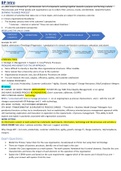Summary
INF3012S BPM & Enterprise Systems Course Summary UCT
- Institution
- University Of Cape Town (UCT)
A summary of the entire course content learnt. These are the notes I used for my exams. A few practice questions are included. These notes were made using the lecture slides in conjunction with the textbook and readers.
[Show more]



